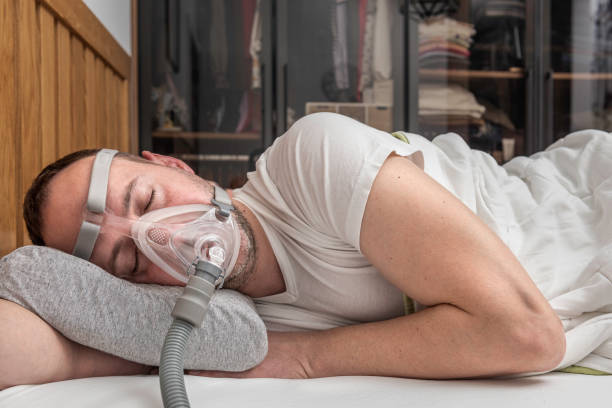Understanding Sleep Apnea and How to Overcome It
Getting a good night’s sleep is crucial for our physical and mental well-being, yet millions of people worldwide struggle with a chronic disorder that repeatedly disrupts and fragments their sleep.

Sleep apnea, characterized by periods of breathing cessation or shallow breathing during sleep, is alarmingly prevalent and can have severe consequences if left untreated. In this comprehensive guide, we’ll dive deep into the world of sleep apnea, exploring its causes, types, symptoms, health risks, diagnosis, and effective treatment strategies to help you or a loved one overcome this disruptive condition.
What is Sleep Apnea?
Sleep apnea is a potentially serious sleep disorder in which a person’s breathing is repeatedly interrupted during sleep. These breathing pauses or shallow breaths can last anywhere from a few seconds to over a minute and often occur multiple times per hour throughout the night. As a result, sleep is extremely fragmented and of poor quality.
There are three main types of sleep apnea:
- Obstructive Sleep Apnea (OSA): The most common form, OSA occurs when the airway becomes blocked or narrowed during sleep, usually due to the relaxation of throat muscles. This blockage causes breathing to repeatedly stop and start.
- Central Sleep Apnea (CSA): In this less common type, the brain fails to properly signal the muscles responsible for breathing. This lack of respiratory drive leads to disrupted breathing patterns.
- Complex Sleep Apnea Syndrome: Also known as treatment-emergent central sleep apnea, this is a combination of both obstructive and central sleep apneas.
While sleep apnea can affect anyone at any age, even children, it is most prevalent in older adults, especially those who are overweight or obese. The chronic sleep deprivation and oxygen deprivation associated with untreated sleep apnea can have serious, wide-ranging impacts on one’s overall health and quality of life.
Signs and Symptoms
Since sleep apnea occurs during sleeping hours, many people with the disorder are unaware they have it. However, there are some common symptoms and warning signs to watch out for:
- Loud, chronic snoring punctuated by silent periods where breathing stops
- Gasping, choking, or snorting sounds during sleep as breathing resumes
- Excessive daytime fatigue and sleepiness, even after a full night’s rest
- Morning headaches, dry mouth, and sore throat upon waking
- Irritability, mood swings, difficulty concentrating, and memory problems
- Restless tossing and turning, insomnia, or frequently waking up at night
- Decreased sexual drive or interest
Often, it is the spouse, partner, or family member who first notices the loud snoring, breathing cessations, and other disturbances caused by an individual’s sleep apnea. If you experience any combination of these symptoms on a regular basis, consult your doctor for an evaluation and sleep study.
Health Risks of Untreated Sleep Apnea
While loud, disruptive snoring may seem like just a nuisance, sleep apnea is a significant medical condition that shouldn’t be ignored. The repeated breathing interruptions and oxygen deprivation put an immense strain on the body, contributing to a variety of potentially serious health issues, such as:
- High Blood Pressure: OSA raises the risk of developing hypertension and can make existing high blood pressure worse.
- Heart Disease: From heart attacks and heart failure to irregular heart rhythms like atrial fibrillation, sleep apnea significantly increases cardiovascular disease risk.
- Stroke: Those with untreated sleep apnea have an elevated risk of suffering strokes.
- Type 2 Diabetes: Sleep apnea is associated with an increased likelihood of insulin resistance, glucose intolerance, and type 2 diabetes.
- Weight Gain: Poor quality sleep can disrupt metabolism, appetite hormones, and fuel overeating and weight gain.
- GERD and Other Digestive Issues: Increased abdominal pressure and oxygen deprivation can exacerbate acid reflux, heartburn, and other gastrointestinal problems.
- Depression and Mood Disorders: The chronic fatigue, stress, and metabolic impacts of sleep deprivation contribute to higher rates of depression and anxiety in those with sleep apnea.
In addition to these health effects, untreated sleep apnea can also lead to excessive daytime sleepiness that increases the risk of drowsy driving and workplace or household accidents. Clearly, proactively treating sleep apnea is crucial for protecting both your overall health and safety.
Getting Evaluated and Diagnosed
If you suspect you may have sleep apnea based on your symptoms, the first step is scheduling an evaluation with your doctor or a sleep medicine specialist. Be prepared to provide a full medical history and have your doctor check for risk factors like:
- Excess weight/obesity, especially with a large neck circumference
- Chronic nasal congestion, deviated septum, or other structural airway issues
- Smoking or excessive alcohol use
- Family history of sleep apnea
- Medical conditions like high blood pressure or endocrine disorders
To definitively diagnose sleep apnea and determine its type and severity, your doctor will likely recommend an overnight sleep study, either at a dedicated sleep lab or through a home sleep apnea test. During these sleep studies, sensors monitor your breathing, oxygen levels, sleep stages, heart rate, snoring, body movements, and more over the course of the night.
Sleep studies provide valuable data on the number of apnea events you experience per hour (called the apnea-hypopnea index or AHI) and the degree of blood oxygen desaturation occurring. This information guides your doctor in formulating an effective treatment plan based on the specifics and severity of your diagnosed sleep disorder.
Treatment Options for Sleep Apnea
The good news is that sleep apnea is a very treatable condition with a variety of highly effective therapy options available, depending on the type, underlying causes, and severity of the disorder. Common treatment approaches include:
CPAP/APAP Therapy
Continuous Positive Airway Pressure (CPAP) therapy, which delivers a steady flow of air through a bedside machine and mask to keep the airway open during sleep, is the most widely used and effective treatment for obstructive sleep apnea. A newer variation called Automatic Positive Airway Pressure (APAP) adjusts the air pressure on a breath-by-breath basis for added comfort.
While CPAP is extremely successful in managing sleep apnea when used properly, some patients struggle with properly adhering to nightly CPAP use due to discomfort from the masks, air pressure, and noise from the machine. Working closely with a sleep specialist to find the right mask fit, pressure settings, and using heating and humidification features can help maximize CPAP compliance.
Oral Appliances
For mild to moderate OSA cases, custom-fitted oral appliances or mandibular advancement devices that reposition the jaw and tongue during sleep to keep the airway open can be an effective alternative to CPAP. These appliances require a dental prescription and fitting.
Surgery
For patients with structural issues like enlarged tonsils, a deviated septum, or severe excess tissue obstructing the airway, corrective surgeries may be recommended. Common procedures include septoplasty, adenoidectomy, nasal surgery, maxillomandibular advancement, and even weight loss surgery in some cases.
Supplemental Oxygen
In cases of certain types of central sleep apnea, using supplemental oxygen along with positive airway pressure can help improve oxygen levels during sleep.
Positional Therapy
Some people with positional OSA that mainly occurs while sleeping on their back may benefit from using positioning devices that help encourage sleeping on the side instead.
In addition to these primary therapies, lifestyle changes like losing weight if overweight or obese, avoiding alcohol close to bedtime, quitting smoking, keeping nasal passages clear, and sleeping on your side can help reduce the frequency and severity of sleep apnea symptoms.
Finding the Right Management Approach
Since sleep apnea is a chronic condition, consistent treatment is essential for alleviating symptoms and associated health risks. Often, a comprehensive approach combining different therapies along with healthy lifestyle habits works best for effective long-term management.
For example, many patients start with CPAP as their primary treatment but also incorporate an oral appliance, positional device, supplemental oxygen, or even temporary medication use as needed for maximum symptom relief. Finding the right combination of therapies through a process of trial and adjustment is key.
It’s also vital to practice good “sleep hygiene” habits: avoid large, heavy meals and alcoholic beverages close to bedtime, establish a calming pre-bedtime routine, maintain a cool and comfortable sleeping environment, go to bed and wake up at consistent times, and minimize potential sleep disruptors like loud noises and bright lights from electronics.

No matter which therapies you utilize, active participation, diligence with the prescribed treatment regimen, and ongoing communication with your sleep doctor are paramount for successfully managing sleep apnea over the long term.
Conclusion
The struggle with sleep apnea is an all-too-common reality for millions worldwide, yet this chronic disorder still often goes undiagnosed and untreated. The consequences of ignoring sleep apnea are severe, from the nightly toll of fragmented sleep and chronic fatigue to the serious health issues like heart disease, stroke, and diabetes that can develop due to repeated oxygen deprivation.
Fortunately, with proper diagnosis through sleep studies and an individualized treatment plan, sleep apnea is an extremely manageable condition. From CPAP and oral appliance therapy to surgery and lifestyle adjustments, a wide range of effective options exists for eliminating night after night of disruptive breathing cessations and restoring consistent, high-quality restorative sleep.
No matter which therapies your doctor recommends based on your specific diagnosis, active participation and diligence in following the prescribed treatment plan are vital. It’s equally important to develop good sleep hygiene habits, maintain open communication with your sleep doctor, and get help from your support system in adhering to your regimen and working through any struggles with treatments like CPAP.
With commitment, consistency, and the right professional care team in your corner, overcoming the nightly battle of sleep apnea is absolutely achievable. Don’t allow this disorder to silently jeopardize your health, wellbeing, and quality of life any longer. By taking a proactive approach to diagnosis and treatment today, you can break free from the vicious cycle of sleep deprivation, fatigue, and health issues to finally start getting the deep, restorative sleep your mind and body needs to thrive.